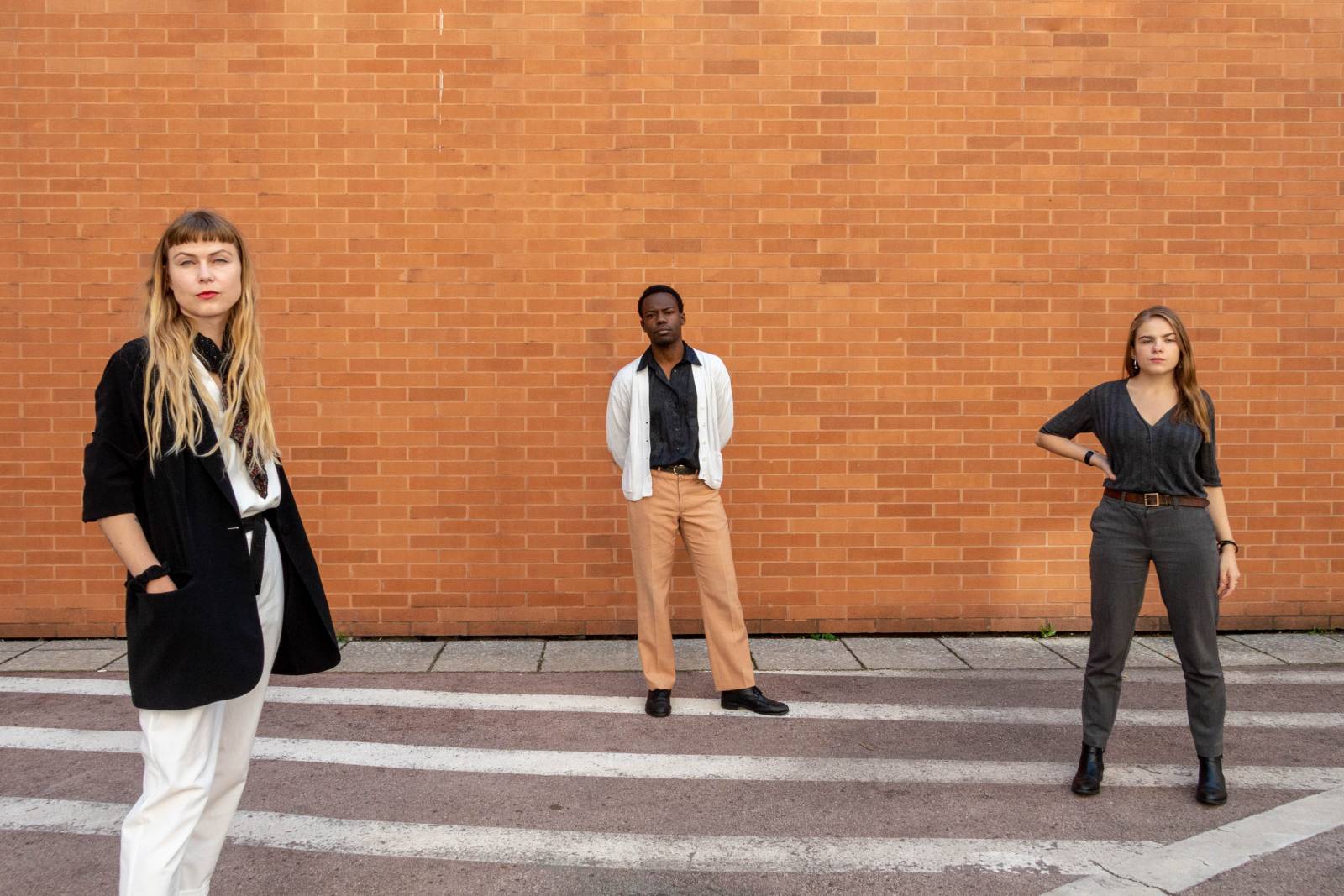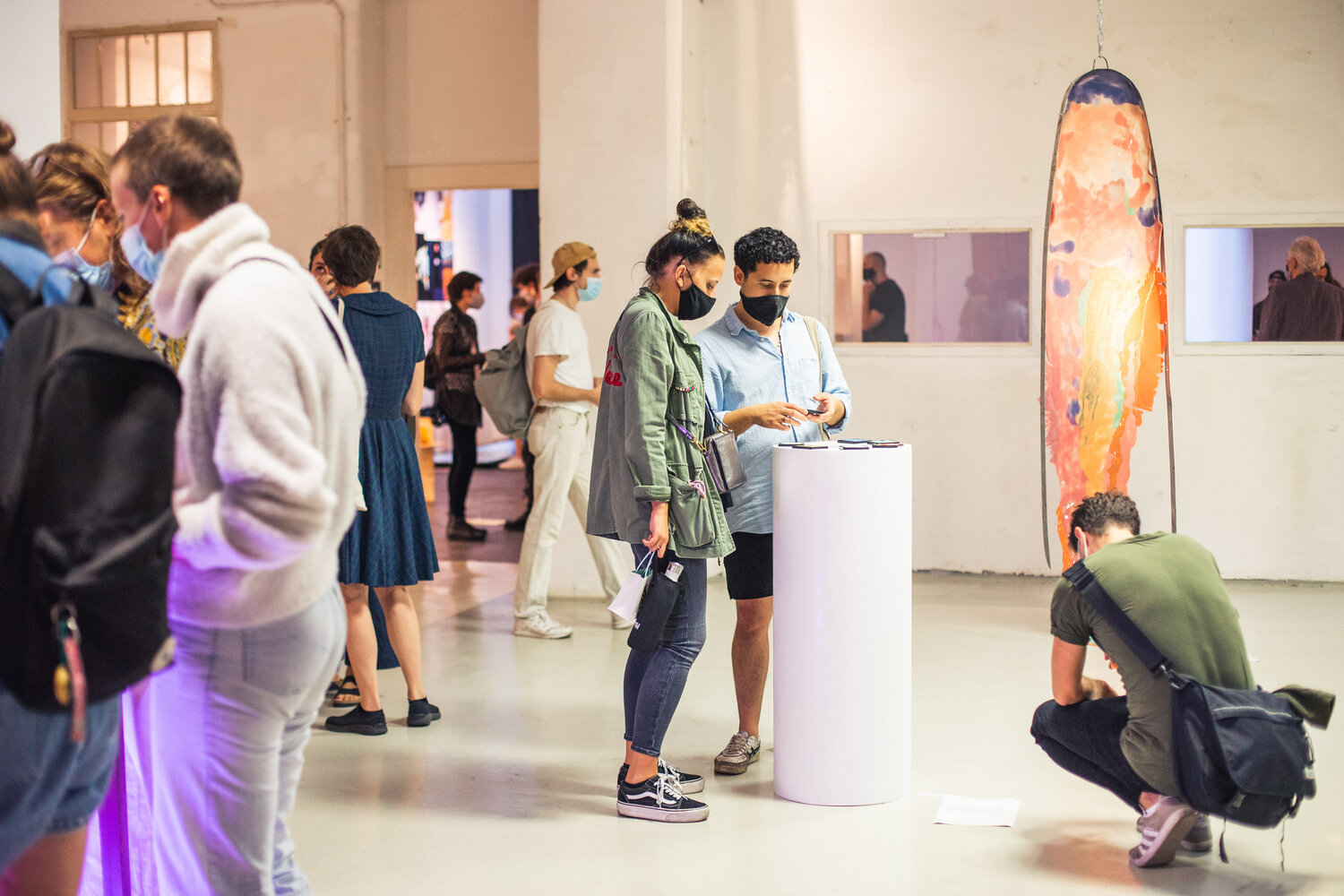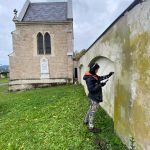Interview with Smaranda of QM&A
QM&A-Project-Coordinators (Justina Speirokaite, Mwita Mataro and Smaranda Krings) / Photo: Maria Belova
QM&A and iOnArt have a history of working together. Now, Smaranda of QM&A and Bastian of iOnArt have paired up to talk about QM&A’s history and future, but she also gave insight on social issues, that migrants are facing when entering Austria and trying to get into the art scene here. Because of the COVID-19 pandemic, the interview has obviously taken place in the digital space, via a video call.
Smaranda at QM&A Artist Collective / Photo: Zoe Opratko
B: Hi Smaranda! To start it off I would like to know: how did the project start and what is your personal background?
S: Hi Bastian! Basically, the whole thing started in 2015. At that time, Osama Zatar, a Palestinian sculptor, and I worked in the same association that supports refugees that are new to Vienna. Since a lot of refugees came to Austria that year, we were curious if and which artists were among them. In order to find that out we organized a big event for artists who have come to Vienna as refugees, but also invited artists that have already been based in Vienna for a long time. At the event we collected the contact information from the artists and went on to put people in touch with each other in order to work together artistically. For a couple of years we did this kind of informally until 2019. Then we decided to formally establish this project as an institution that specifically helps artists who have only recently come to Austria to get a foot into the Austrian art scene.
B: What were the obstacles at the beginning?
S: Of course, one major obstacle is that you have to get funding. We are very that happy that the City of Vienna is now supporting our project financially. It is indeed a project that benefits the City of Vienna – it’s great that the City of Vienna recognizes it as an asset and supports us accordingly. Furthermore, you have to invest a lot of work in finding your target group, because artists who have just recently come to Austria often don’t know a lot of people yet and could find it very difficult to find our institution. This means, for example, that you have to ask yourself the question: “What is the first contact point for people who have just come to Austria?
B: What would you say it is more likely: you find the people or the people find you?
S: Well, we do a lot of research and ask around. The main reason for this is simply that artists who come to Austria as refugees first need to overcome bureaucratical hurdles and settle before starting to think of working as an artist again – there are simply different priorities at the beginning. We offer an opportunity to get to know people in the Viennese art scene and build up a network.
„Final exhibition of the QM&A Artist Collective 2020 (I)“ / Photo: Zoe Opratko
B: What would you advise someone who is just starting a project like yours?
S: You need a lot of stamina in the beginning. You have to be willing to do a lot of unpaid work, which of course is easier if you are convinced of the importance of your project.
B: You founded your company to help artists who are not from Austria to enter the art world in Vienna. What is your long-term goal?
S: The long-term goal is, of course, that the positions in Viennese cultural institutions are filled with cultural workers with different backgrounds. In other words, we want to support people in finding an entrance into the Vienna art scene and get into higher positions in big institutions. That is why our long-term goal is to also act as a headhunting firm with a focus on artists and cultural workers that are new to Vienna.
B: One of your projects is the „QM&A Artist Collective“. Who exactly is qualified to apply for your „Open Calls“?
S: Basically every artist who lives in Vienna. The concept of this project is that half of the artists are from Vienna, who already know the scene very well, and the other half are migrants or refugees that only recently moved to Vienna. We then divide the participants into pairs – each artist who knows the scene well is assigned an artist who only recently moved to Austria. Both parties benefit from this. On the one hand, the Austrian artists gain new insights and perspectives, on the other hand, the new artists get to know the art scene, expand their network and profit from the experience of their counterpart.
„Final exhibition of the QM&A Artist Collective 2020 (I)“ / Photo: Zoe Opratko
B: I did some research and found out that you use the „Improper Walls“ gallery for your exhibitions. Why exactly this one?
S: Improper Walls is a non-profit gallery that has been working in the Vienna art scene for many years. When we established QM&A it was clear that the gallery would play a big part in our program. The QM&A Artist Collective is curated by the curators from Improper Walls. Furthermore, Justina Speirokaite, who is one of the founding members of Improper Walls, co-initiated QM&A with me and is one of the main project coordinators.
B: What criteria do you use to select participants for your „QM&A Artist Collective“?
S: We select artists based on their artistic work but also think of possible artistic partners. If we can imagine a good collaboration with another artist that has applied we are likely to select them both. The couples we put together always work with different mediums.
B: I have seen on your Instagram page that there are a lot of performance acts.
S: Yes, that is very exciting. For example, in the last “QM&A Artist Collective” a painter and a performer worked together. The work they developed was a painting on which a video of a performance piece was projected.
„Final exhibition of the QM&A Artist Collective 2020 (I)“ / Photo: Zoe Opratko
B: The next project I found from you is the „QM&A On Stage“, which was done for the first time this year. Would you call it a success?
S: Yes, it was an absolute success and we will do it again next year. Of course, it has now been moved to the digital space because of COVID-19. The four selected musicians have already received their prizes. But they were not able to perform in the „Schauspielhaus“ as planned. Instead, we produced videos of the award ceremony that will go online soon. In the framework of the award ceremony the winners were also interviewed by the two musicians Amy Wald and Tmnit Ghide.
B: How do you go about making yourself well known in Vienna?
S: We do a lot of press work and are very grateful to be supported in this by the PR agency „Studio Vincent“. Especially for “QM&A On Stage” we received a lot of press attention – we were on FM4, Ö1 and will soon be in many lifestyle magazines. In the next few weeks we will do even more press work for the musicians who won. So it’s all going uphill and for the fact that we’ve only been working in this form for a year, we’ve already come quite far.
„Final exhibition of the QM&A Artist Collective 2020 (I)“ / Photo: Zoe Opratko
B: You also have a „Kids Summer“. Why is it so important for you to give children the chance to express themselves artistically and what value does this add for society in your opinion?
S: This is a fun project, which we have only done once so far, but we definitely want to do it again next summer. Although it is not the core task of our project to give art lessons to children, we still want to give artists an opportunity to teach art in the summer as a side job. Similar to the “QM&A Artist Collective” we want to get people from different circles to meet. This is achieved by having different paying schemes for this summer course depending on the income situation of the parents. This results in a much more mixed group, as lower-income families have the same opportunities as higher-income families. Our goal is to give children the chance to spend a week in summer getting to know other children from different social groups and learn from each other.
„Final exhibition of the QM&A Artist Collective 2020 (I)“ / Photo: Zoe Opratko
B: Unfortunately, many immigrants and refugees do not have an easy time of it when they arrive in Austria. What else do you think has to happen to make it easier to settle into the Austrian art scene?
S: I think there should be many more projects like ours. There need to be more points of contact and the Austrian art scene needs to become more open to new people. Many migrants confirm again and again that it is incredibly difficult to get into the Vienna art scene because it is a closed circle of people who have known each other for ages. What it also necessary is that less emphasis is placed on whether one has a degree from an Austrian art university or not. The assumption that you need a degree to be able to sell many of your works is still too strongly held. The problem is that many migrants have a degree from an art university in their country, but it is not accredited here.
B: In any case, these are big problems that make it much more difficult to gain a foothold here. What I also find very difficult is that you need a very high level of German at art universities – sometimes even C1, which is almost mother tongue level. In a field like art, that doesn’t make much sense, because art is a language in its own right and you don’t need a lot of „ordinary“ language skills.
S: Yes, these are structural obstacles. Especially when you consider that places like the “Akademie der Bildenden Künste” are actually places where a lot of contacts are made. That’s where you can enter the scene. If not everyone has the same opportunities, I see that as problematic.









